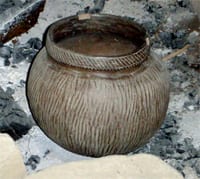Contact between Old World and New World populations resulted in the exchange of ideas, technologies, and practices that dramatically changed world cultures. The Columbian Exchange also resulted in the spread of invasive species, including catastrophic Old World epidemic diseases like influenza, measles, and smallpox. The impacts on peoples in the Americas was disaster. In some areas fifty to eighty percent of the population died. Archaeology has contributed to our understanding of the spread of such epidemics. However, there has often been a focus on when and where disease outbreaks occurred and how many people were affected. Less attention has been given to what life was like for survivors. How did these individuals put their lives and societies back together after devastation?
Using theoretical assumptions from the anthropology of disaster and technology, the social impacts of smallpox on survivors can be explored. Such an approach is important, especially in areas with no written record. This presentation explores how the Hidatsa, a group of earthlodge villagers in North Dakota visited by Lewis and Clark and home of Sacajawea, responded to the smallpox epidemics of the 18th and 19th centuries. Specifically, how did individuals maintain or modify daily practice in light of these catastrophic events? This is an important topic to consider because the decisions and actions of those who endured these processes resulted in culture change and cultural survival for Native American Nations today.
Kacy Hollenback is an anthropologically trained archaeologist with interests in hazards and disaster research. She received my Ph.D. from the School of Anthropology at the University of Arizona (UA) in 2012. She now teaches at the Department of Anthropology, Southern Methodist University.
As an archaeologist, her research emphasis is on potential disruptions to traditional technological systems and the roles of traditional technologies in post-disaster coping. Most often her work examines the long-term legacies of disaster—over the course of decades or generations.
Her current regional expertise is Northern Plains archaeology and anthropology. She maintains her interest in the American Southwest. Over the last decade, she has conducted archaeological and anthropological research in North Dakota and Montana in collaboration with the Bureau of Applied Research in Anthropology, State Historical Society of North Dakota, National Park Service, and numerous Plains tribes.


